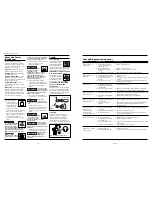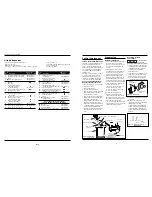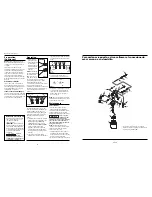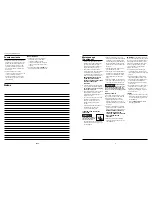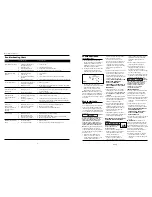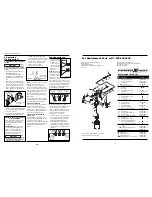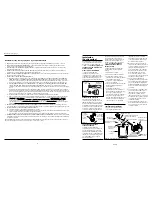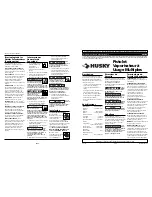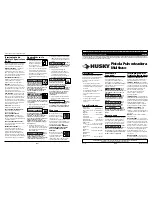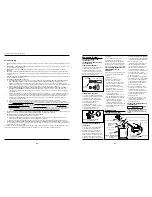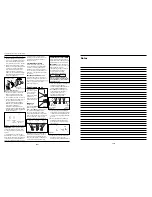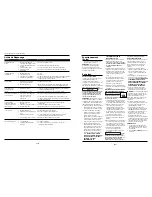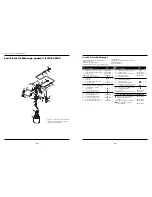
25 Sp
S
P
33
32
24
23
22
2
3
1
4
5
21
*
6
8
9
10
11
16
15
14
13
12
17
18
19
20
25
29
30
31
28
27
26
Para ordenar repuestos, sirvase llamar al concesionario
más cercano a su domicilio
* Las roscas de la conexión entre el tanque
externo de pintura y la manguera de material
son de 9,5mm (3/8”) NPS (M)
Operation
1. Begin spraying.
Always keep the
gun at right angles
to the work by
flexing your wrist
while making the
paint stroke. (See
Figure 6).
NOTE:
Do
not
keep
the wrist stiff during
the stroke and do
not
“fan” the gun
from side to side in
an arc while spraying. This type of
motion brings the gun close to the
surface and deposits a heavy
concentration of material in the center
of each stroke and applies an
insufficient concentration of material at
the end of the stroke. This will make a
very poor, irregular paint job (See
Figure 7).
Keep the nozzle about 6 to 9 inches
from the work surface throughout the
stroke and always keep the gun in
motion while spraying. Stopping gun
movement in mid-stroke will cause a
build up of material and result in
“runs.”
2. “Trigger” the gun properly. Start the
gun moving at the beginning of the
stroke BEFORE SQUEEZING THE
TRIGGER and release the trigger
BEFORE STOPPING GUN MOVEMENT
at the end of the stroke. This
procedure will “feather” (blend)
each stroke with the next without
showing overlap or unevenness (See
Figure 8).
3. The amount of material being
applied can be varied by the speed of
the stroke, distance from the surface
and adjustment of the fluid control
knob.
4. Overlap strokes just enough to
obtain an even coat (See Figure 9).
5. Use a piece of cardboard as a shield
to catch overspray at the edges of
the work to protect other surfaces.
Use masking tape to cover other
areas if needed.
NOTE:
Two thin coats of material will
yield better results and have less chance
of runs than one heavy layer.
Maintenance
DAILY CLEAN-UP
Local codes may require specific
cleaning methods and equipment.
Follow local codes and manufacturer’s
recommendations for the use and
disposal of spray materials and solvent.
Clean spray gun
immediately after
use. Paint and other materials dry
quickly in the small passages rendering
gun useless due to the difficulty of
removing hardened materials from the
passages inside the gun.
NOTE:
In the instructions below,
“solvent” refers to the specific solvent
for the material used (eg: lacquer
thinner for lacquer, etc ).
1. Spray guns with canister—Remove
and empty the canister; then rinse
with a solvent recommended for the
paint or other material used.
2. Refill canister with clean solvent and
NOTICE
Preparation
(Continued)
NOTE:
If there is sagging, too much
material is being applied. If there is an
“orange peel” effect, the material is
too thick.
If the spray is too fine (excessive
overspray), caused by too much air for
the amount of paint being sprayed,
reduce the air pressure or open the
fluid control to spray more material.
If the spray is too coarse (spitting
globs), reduce the amount of material
with the fluid control knob or thin the
material.
DISTANCE ADJUSTMENTS
Start 6” away from work surface. If
pattern begins to run, move back an
inch and try again. The pattern will be
dry and thin and may feel rough if
sprayed from too far away.
SPEED OF STROKE ADJUSTMENTS
If speed of stroke is too slow, paint will
be wet on work surface and may run. If
speed of stroke is too fast, paint will be
dry and uneven on work surface.
4
Multi-Purpose Spray Gun
WATER/OIL IN COMPRESSED AIR
All compressor pumps discharge
some condensed water, oil or
contaminates with the
compressed air.
IMPORTANT:
This condensation
will cause “fish eyes” to appear in
the paint job. Install appropriate
water/oil removal equipment (such
as filters and dryers) and controls as
necessary for the intended
application.
Failure to
install
appropriate water/oil removal
equipment may result in damage
to machinery or workpiece.
NOTICE
6 - 9”
Figure 6
Thin Coat
Thin Coat
Heavy Coat
Figure 7
INCORRECT
6 - 9”
Pull
Trigger
Start
Stroke
Release
Trigger
End
Stroke
Figure 8
Figure 9


